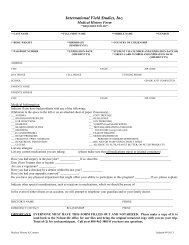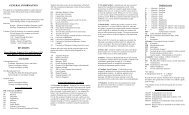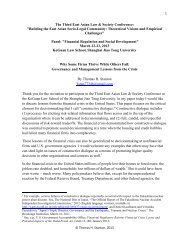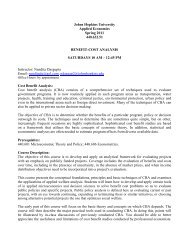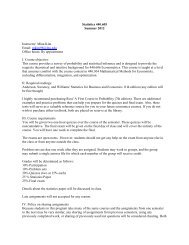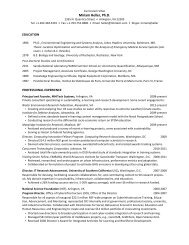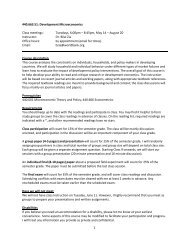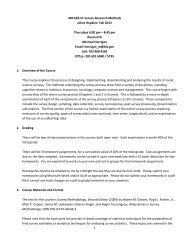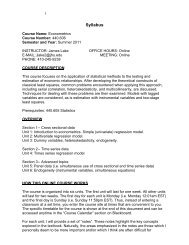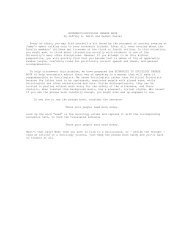Principles and Applications of Energy Technology - Advanced ...
Principles and Applications of Energy Technology - Advanced ...
Principles and Applications of Energy Technology - Advanced ...
Create successful ePaper yourself
Turn your PDF publications into a flip-book with our unique Google optimized e-Paper software.
Herzog, Howard <strong>and</strong> Katzner, James “The Future <strong>of</strong> Coal in a Greenhouse Gas Constrained World”MIT paper (2004). http://sequestration.mit.edu/pdf/GHGT8_Herzog_Katzer.pdf (Supplementaryreading – Optional)9: Electricity Storage & Integration Issues & GeothermalThis class first will cover the potential role electricity storage. There are a variety <strong>of</strong> potential electricitystorage technologies, including pumped hydro, compressed air energy storage (CAES), batteries <strong>and</strong>capacitors that can provide an array <strong>of</strong> grid <strong>and</strong> generation applications, that in principle could lead to amore operationally efficient grid, including deferring the need for new transmission <strong>and</strong> distributionbuild, <strong>and</strong> facilitating the integration <strong>of</strong> large amounts <strong>of</strong> wind. There are a number <strong>of</strong> barriers to thelarge scale implementation <strong>of</strong> storage, however, including cost <strong>and</strong> market structure considerations. Theenvironmental benefits <strong>of</strong> storage are less clear cut, <strong>and</strong> somewhat application <strong>and</strong> location specific, <strong>and</strong>this will be discussed.A second topic covered will be geothermal energy. This is really quite a separate topic from storagecovered above – though it does use energy stored in the Earth’s crust.Sioshansi Ramteen, Denholm, Paul, Jenkin, Thomas <strong>and</strong> Weiss, Jurgen, “Estimating the Value <strong>of</strong>Electricity Storage in PJM: Arbitrage <strong>and</strong> Some Welfare Effects”, <strong>Energy</strong> Economics, 31, 269-277,March 2009.<strong>Energy</strong> Science (Andrews <strong>and</strong> Jelley (2007)). Chapter 10 - Generation <strong>and</strong> Transmission <strong>of</strong>Electricity, <strong>Energy</strong> Storage, <strong>and</strong> Fuel Cells: Sections 10.5 to 10.14 on storage technologies <strong>and</strong> fuelcells.10: Biomass <strong>Energy</strong> <strong>and</strong> Introduction to TransportationThis class will cover Biomass <strong>and</strong> Bi<strong>of</strong>uels; what they are, their sources, <strong>and</strong> how they can be used forheat, power generation <strong>and</strong> transportation. The class will include discussion <strong>of</strong> whether bi<strong>of</strong>uels can beconsidered largely carbon neutral, the relative effectiveness <strong>of</strong> different biomass sources (sugar cane vs.corn vs. cellulosic), including the social <strong>and</strong> policy implications <strong>of</strong> subsidies <strong>and</strong> competing uses for l<strong>and</strong>(e.g. food vs. fuel), <strong>and</strong> their potential value in reducing dependence on oil.Childs Staley, Britt <strong>and</strong> Bradley, Rob,”Plants at the Pump: Reviewing Bi<strong>of</strong>uels’ Impacts <strong>and</strong> PolicyConsiderations”, Climate <strong>and</strong> <strong>Energy</strong> Policy Series, , World Resources Institute, July 2008.http://pdf.wri.org/plants_at_the_pump_brief.pdf<strong>Energy</strong> Science (Andrews <strong>and</strong> Jelley (2007)). Chapter 7 - Biomass: Sections 7.1 to 7.6 [Completechapter]. The entire chapter is worth readingChilds Staley, Britt <strong>and</strong> Bradley, Rob, Plants at the Pump: Bi<strong>of</strong>uels, Climate Change <strong>and</strong>Sustainability, World Resources Institute, December 2007. http://pdf.wri.org/plants_at_the_pump.pdf(Supplementary reading – Optional)Fargione et al, “L<strong>and</strong> Clearing <strong>and</strong> the Bi<strong>of</strong>uel Carbon Debt”, Science, 319, 1235, February 29, 2008. 8(Supplementary reading – Optional)11: Transportation8 There is quite a highly charged debate going on over the benefits <strong>and</strong> costs <strong>of</strong> biomass from a carbonneutrality perspective. This paper covers one side <strong>of</strong> the argument. Other papers will be added to this syllabusto facilitate a class discussion on the topic. It should not be assumed necessarily that the instructor endorseseverything written in this paper, or for that matter other reading material.DRAFT, August 23 rd 2012 (original version January 11, 2010, <strong>and</strong> previously updated August 24, 2010 <strong>and</strong>May 20 , 2011, <strong>and</strong> January 6, 2012). Based in part with modifications on course instructor developed forEnvironmental Challenges for <strong>Energy</strong> <strong>Technology</strong> <strong>and</strong> Policy (Original syllabus drafted September 1 st 2008,updated August 15 th 2009)




